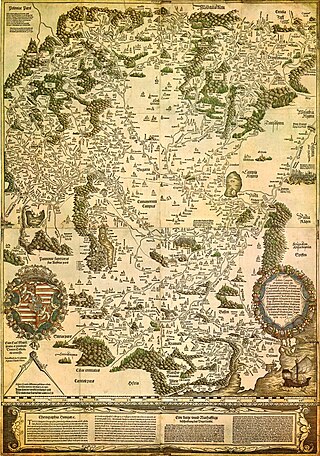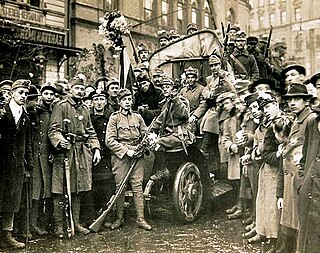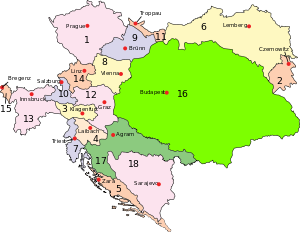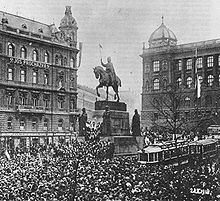
Austria-Hungary, often referred to as the Austro-Hungarian Empire or the Dual Monarchy, was a multi-national constitutional monarchy in Central Europe between 1867 and 1918. Austria-Hungary was a military and diplomatic alliance of two sovereign states with a single monarch who was titled both emperor of Austria and King of Hungary. Austria-Hungary constituted the last phase in the constitutional evolution of the Habsburg monarchy: it was formed with the Austro-Hungarian Compromise of 1867 in the aftermath of the Austro-Prussian War and was dissolved shortly after Hungary terminated the union with Austria on 31 October 1918.

Pan-Slavism, a movement that took shape in the mid-19th century, is the political ideology concerned with promoting integrity and unity for the Slavic people. Its main impact occurred in the Balkans, where non-Slavic empires had ruled the South Slavs for centuries. These were mainly the Byzantine Empire, Austria-Hungary, the Ottoman Empire, and Venice.

Charles I or Karl I was Emperor of Austria, King of Hungary, King of Croatia, King of Bohemia, and the last of the monarchs belonging to the House of Habsburg-Lorraine to rule over Austria-Hungary. The son of Archduke Otto of Austria and Princess Maria Josepha of Saxony, Charles became heir presumptive of Emperor Franz Joseph when his uncle Archduke Franz Ferdinand of Austria was assassinated in 1914. In 1911, he married Princess Zita of Bourbon-Parma. He is venerated in the Catholic Church, was beatified by Pope John Paul II on 3 October 2004, and is known to the Catholic Church as Blessed Karl of Austria.

Austrians are the citizens and nationals of Austria. The English term Austrians was applied to the population of Habsburg Austria from the 17th or 18th century. Subsequently, during the 19th century, it referred to the citizens of the Empire of Austria (1804–1867), and from 1867 until 1918 to the citizens of Cisleithania. In the closest sense, the term Austria originally referred to the historical March of Austria, corresponding roughly to the Vienna Basin in what is today Lower Austria.

The Treaty of Trianon often referred to as the PeaceDictate of Trianon or Dictate of Trianon in Hungary, was prepared at the Paris Peace Conference and was signed in the Grand Trianon château in Versailles on 4 June 1920. It formally ended World War I between most of the Allies of World War I and the Kingdom of Hungary. French diplomats played the major role in designing the treaty, with a view to establishing a French-led coalition of the newly formed states.

The Treaty of Saint-Germain-en-Laye was signed on 10 September 1919 by the victorious Allies of World War I on the one hand and by the Republic of German-Austria on the other. Like the Treaty of Trianon with Hungary and the Treaty of Versailles with the Weimar Republic, it contained the Covenant of the League of Nations and as a result was not ratified by the United States but was followed by the US–Austrian Peace Treaty of 1921.

The phrase Imperial and Royal refers to the court/government of the Habsburgs in a broader historical perspective. Some modern authors restrict its use to the Dual Monarchy of Austria-Hungary from 1867 to 1918.

The Habsburg monarchy, also known as Habsburg Empire, or Habsburg Realm, was the collection of empires, kingdoms, duchies, counties and other polities that were ruled by the House of Habsburg. From the 18th century it is also referred to as the Danubian monarchy or the Austrian monarchy.

The United States of Greater Austria was an unrealised proposal made in 1906 to federalize Austria-Hungary to help resolve widespread ethnic and nationalist tensions. It was conceived by a group of scholars surrounding Archduke Franz Ferdinand of Austria, notably by the ethnic Romanian lawyer and politician Aurel Popovici.
Vojvodina is an autonomous province located in northern Serbia. It consists of the Pannonian Plain in the south, and the Danube and Sava rivers in the north.

There was a period of revolutions and interventions in Hungary between 1918 and 1920. The First Hungarian Republic was founded from the ruins of the Austro-Hungarian Empire by Mihály Károlyi during the Aster Revolution in 1918, at the end of World War I. In March 1919, the republic was overturned by another revolution, and the Hungarian Soviet Republic was created. Unresolved conflicts led to wars between Hungary and its neighbor states in 1919. The Hungarian Soviet Republic ceased to exist after the Romanian occupation. The 1920 Treaty of Trianon in Versailles created the Kingdom of Hungary.

The Republic of German-Austria was an unrecognised state that was created following World War I as an initial rump state for areas with a predominantly German-speaking and ethnic German population within what had been the Austro-Hungarian Empire, with plans for eventual unification with Germany. The territories covered an area of 118,311 km2 (45,680 sq mi), with 10.4 million inhabitants.

Yugoslavia was a state concept among the South Slavic intelligentsia and later popular masses from the 19th to early 20th centuries that culminated in its realization after the 1918 collapse of Austria-Hungary at the end of World War I and the formation of the Kingdom of Serbs, Croats and Slovenes. However, the kingdom was better known colloquially as Yugoslavia ; in 1929 it was formally renamed the "Kingdom of Yugoslavia".

At the outbreak of World War I in August 1914, Hungary was part of the Dual Monarchy of Austria-Hungary. Although there are no significant battles specifically connected to Hungarian regiments, the troops suffered high losses throughout the war as the Empire suffered defeat after defeat. The result was the breakup of the Empire and eventually, Hungary suffered severe territorial losses by the closing Trianon Peace Treaty.

Foreign relations exist between Austria and Serbia and their predecessor states. Austria has an embassy in Belgrade. Serbia has an embassy in Vienna and a general consulate in Salzburg. Austria is a European Union member and Serbia is a European Union candidate.

The Aster Revolution or Chrysanthemum Revolution was a revolution in Hungary led by Count Mihály Károlyi in the aftermath of World War I. It resulted in the foundation of the short-lived First Hungarian People's Republic.

The May Declaration was a manifesto of political demands for unification of South Slav-inhabited territories within Austria-Hungary put forward to the Imperial Council in Vienna on 30 May 1917. It was authored by Anton Korošec, the leader of the Slovene People's Party. The document was signed by Korošec and thirty-two other council delegates representing South-Slavic lands within the Cisleithanian part of the dual monarchy – the Slovene Lands, the Dalmatia, Istria, and the Condominium of Bosnia and Herzegovina. The delegates who signed the declaration were known as the Yugoslav Club.

In the history of Austria-Hungary, trialism was the political movement that aimed to reorganize the bipartite Empire into a tripartite one, creating a Croatian state equal in status to Austria and Hungary. Franz Ferdinand promoted trialism before his assassination in 1914 to prevent the Empire from being ripped apart by Slavic dissent. The Empire would be restructured three ways instead of two, with the Slavic element given representation at the highest levels equivalent to what Austria and Hungary had at the time. Serbians saw this as a threat to their dream of a new state of Yugoslavia. Hungarian leaders had a predominant voice in imperial circles and strongly rejected Trialism because it would liberate many of their minorities from Hungarian rule they considered oppressive.
World War I began when Austria-Hungary invaded Serbia in July 1914, following the Assassination of Archduke Franz Ferdinand by Gavrilo Princip. Austria-Hungary was one of the Central Powers, along with the German Empire and the Ottoman Empire. Austro-Hungarian forces fought the Allies in Serbia, on the Eastern Front, in Italy, and in Romania. With heavy aid and support from its allies, the empire managed to occupy Serbia in 1915 and force Romania out of the war in 1917. On the other fronts, it suffered severe casualties, culminating in the collapse of the Italian front, which led the Austrians to accept the Armistice of Villa Giusti on 3 November 1918.
The armistice of Belgrade was an agreement on the termination of World War I hostilities between the Triple Entente and the Kingdom of Hungary concluded in Belgrade on 13 November 1918. It was largely negotiated by General Louis Franchet d'Espèrey, as the commanding officer of the Allied Army of the Orient, and Hungarian Prime Minister Mihály Károlyi, on 7 November. It was signed by General Paul Prosper Henrys and vojvoda Živojin Mišić, as representatives of the Allies, and by the former Hungarian Minister of War, Béla Linder.

























